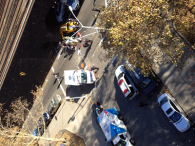|
IRF2016 Porto 24-28 July 2016 |
5th International Conference INTEGRITY-RELIABILITY-FAILURE Faculty of Engineering / U. Porto, 24-28 July 2016 |
|
Keynote Speakers The IRF2016 program will include a number of Keynote Lectures by distinguished professionals and scientists in the different areas covered by the Main Topics and Symposia of the conference, to provide thematic presentations of their most recent developments. The names of the following Keynote Speakers and the titles of their presentations have already been confirmed (ordered by date of confirmation): Prof. Shaker A. Meguid (Canada) Prof. Thomas Tröster (Germany)
Director, Mechanics and Aerospace Design Laboratory University of Toronto, CANADA Email: [email protected]
Title of Presentation:
COMPUTATIONAL CONTACT MECHANICS USING VARIATIONAL INEQUALITIES: THEORY AND APPLICATIONS
ABSTRACT
Dynamic contact plays an important role in dictating the integrity, performance and safety of many engineering systems/components. Despite their importance to the mechanical integrity of these systems, dynamic contact effects are frequently treated using oversimplifying assumptions, which neglect the main features of the problem. The reason is that modeling dynamic contact in solids poses mathematical and computational difficulties. With the application of loads to the bodies in contact, the actual surface upon which these bodies meet change with time, and the contact stresses that act at these surfaces are generally unknown. Analytical closed form solutions for contact problems were developed by Hertz in 1882. Hertz classical theory of contact was developed for elastic quasi-static frictionless bodies with the contact region being small compared with the dimensions of the contacting bodies. In spite of the fact that Hertz's theory of contact bas stood the test of time and has been a landmark in applied mechanics for many decades, it suffers from the above- mentioned severe restrictions. In this keynote lecture, we will develop novel formulations for dynamic contact problems using variational inequality. Three aspects of the work will be examined; these include the development of: (i) dynamic variational inequalities expressions to accurately and consistently represent dynamic contact problems, (ii) robust solution algorithms that guarantee the accurate imposition of the kinematic contact constraint to avoid interpenetration of the mating bodies, and (iii) realistic and novel designs using the newly developed variational inequalities algorithms. The design problems studied include aeroengine compressor/turbine disc assemblies (Fig. 1), birdstrike, aerial refuelling (Fig. 2), shot-peening, crush behaviour of thin walled tubular columns and finger implants.
Automotive Lightweight Design Institute of Hybrid Lightweight Design (ILH) University of Paderborn, Germany Email: [email protected] www.leichtbau-im-automobil.de
Title of Presentation:
CRASHWORTHINESS OF HYBRID METAL / FIBER-REINFORCED PLASTIC STRUCTURES
ABSTRACT Due to the relevance of ecological constraints, as reduced CO2 emissions and the limitation of available resources, automotive lightweight becomes increasingly important. However, in spite of reduced vehicle masses and the attended fuel saving the car occupant protection must at least remain the same or has to be improved. To reach this ambitious aim innovative and new material concepts are necessary. For material-based lightweight design the use of high- and ultra-high-strength metal alloys or the substitution by fibre-reinforced plastics (FRP) represent current work. Another approach is the application of hybrid structures consisting of metal and FRP parts. Thus, complex mechanical or as well physical-chemical properties can be combined within one structural component. Crashworthiness is one of the major dimensioning parameter for these innovative structural applications. The application of hybrid components in high volume automotive car bodies meets the following three main challenges, which will be addressed in this keynote lecture: (i) Development of new manufacturing processes for hybrid components. (ii) Capable finite-element (FE) simulation methods for computer aided-engineering (CAE). (iii) Advanced testing methods for realistic predictions and generating of simulation parameters. The studied problems focus on front- and side impact automotive structures. For the assessment of the crashworthiness of the hybrid structures the specific energy absorption is considered. The presented study covers the complete process chain from manufacturing to recycling.
Professor Michel van Tooren Aerospace Systems Design and Structures Deputy Director Ronald E. McNAIR Center for Aerospace Innovation and Research University of South Carolina, Columbia, SC, 29201 Email: [email protected]
Title of Presentation:
MDO APPROACH TO OPTIMAL VARIABLE STIFFNESS STRUCTURE DESIGN
ABSTRACT
The next
level of performance of composite structures is likely
to come from three major changes. First, the development
of a variable stiffness design and manufacturing
principles. These will allow simultaneous design of load
distribution and strength distribution. Second, the
development of fusion bonding based assembly of
thermoplastic composites using induction, laser and
ultrasonic heating principles. Figure 1 shows a recent
and unique welded thermoplastic (constant stiffness)
carbon composite control surface for a business jet.
Third, the development of multi-polymer composite
structures. Thermoset and thermoplastic polymers offer
different advantages when con In this keynote lecture, we will present a framework for the design of variable stiffness fiber composite panels subject to multiple load cases; each case is a combination of biaxial loading involving tension and shear. The framework consists of a finite element (FE) solver, an optimizer, a module that controls the link between the design variables and the stiffness matrix in the FE module and a postprocessor that translates the optimal result from the optimizer into discrete tow paths for each ply. The dual mesh formulation of the design variables, using a manufacturing mesh separate from the FE mesh, limits the number of design variables while preserving smoothness and allows easy specification of the manufacturing constraints enforced by the envisioned fiber steering process; for example - the minimum course radius to prevent tow buckling. It also allows the incorporation of constraints related to fusion bonding techniques for continuous carbon fiber reinforced thermoplastic composites based on induction heating, which require the generation of eddy currents, and therefore constrain the fiber orientations and stacking sequence. The nonconventional character of steered structures requires an alternative approach to the demonstration of structural integrity. Some directions for the solution approach will be considered in this talk.
Page created on 20 January 2015 / Last update on 25 May 2015 |
|
 Professor
Shaker Meguid
Professor
Shaker Meguid


 Dr.
Michel van Tooren is Professor of Aerospace Systems
Design and Structures at the College of Engineering and
Computing (CEC) of the University of South Carolina and
deputy director of the Ronald E. McNAIR Center for Aerospace
Innovation and Research. Michel has a BSc, MSc and PhD in
Aerospace Engineering and joined CEC in September 2013.
Before joining USC he worked for Fokker Aerostructures in
the Netherlands as Manager New Concept Development. He
combined this position in industry with a part-time
appointment at the Faculty of Aerospace Engineering of the
Delft University of Technology. Prior to that he worked ten
years as professor Systems Integration Aircraft at the same
University, building a group specialized in Aircraft Design,
Flight Mechanics and Multi-disciplinary Design Optimization.
This group became well-known for its work in MDO, Aircraft
Design, KBE and Truck Aerodynamics. He combined the research
activities with a position in the management team of the
faculty of Aerospace Engineering as vice dean. All this
followed a previous ten years of research, education and
innovation in design of composite structures. His research
focus at CEC is on design and manufacture of composites
structures. In addition he serves as the Program Director
Aerospace Engineering Studies for CEC.
Dr.
Michel van Tooren is Professor of Aerospace Systems
Design and Structures at the College of Engineering and
Computing (CEC) of the University of South Carolina and
deputy director of the Ronald E. McNAIR Center for Aerospace
Innovation and Research. Michel has a BSc, MSc and PhD in
Aerospace Engineering and joined CEC in September 2013.
Before joining USC he worked for Fokker Aerostructures in
the Netherlands as Manager New Concept Development. He
combined this position in industry with a part-time
appointment at the Faculty of Aerospace Engineering of the
Delft University of Technology. Prior to that he worked ten
years as professor Systems Integration Aircraft at the same
University, building a group specialized in Aircraft Design,
Flight Mechanics and Multi-disciplinary Design Optimization.
This group became well-known for its work in MDO, Aircraft
Design, KBE and Truck Aerodynamics. He combined the research
activities with a position in the management team of the
faculty of Aerospace Engineering as vice dean. All this
followed a previous ten years of research, education and
innovation in design of composite structures. His research
focus at CEC is on design and manufacture of composites
structures. In addition he serves as the Program Director
Aerospace Engineering Studies for CEC. sidering
the mechanical properties and their manufacturing. It is
advantageous to have zones of thermoplastic and zones of
thermoset composite in a single structural element. To
successfully combine these three developments, the
scientific and engineering challenge is to design and
create materials and structures for optimal performance
taking into account requirements such as stiffness,
strength, conductivity, thermal expansion, and the
ability to be fusion bonded at selected zones. This
requires a fundamental understanding of the
multi-physical properties of variable stiffness,
multi-polymer composite laminates and shells. This
keynote focuses on the modelling and the optimization of
fiber steering, a specialized version of automated fiber
placement (AFP), to support the design of variable
stiffness structures. Whilst in normal AFP, one tries to
minimize non-geodesical placement of fibers in a part,
fiber steering actually tries to utilize non-geodesical
placement of fibers to control the load paths in the
laminate as well as the laminate strength. Load path
control is achieved by varying material stiffness with
respect to a fixed coordinate system from point-to-point.
At the same time, the strength of the laminate is
influenced by the steering, since the strength of a
laminate is directly related to the fiber directions in
its constituting plies. Design for fiber steering
therefore aims at the best match between applied loads
and strength at each point of the laminate. In addition
to tuning stiffness, steering can be used to control
other physical properties that depend on fiber
orientation.
sidering
the mechanical properties and their manufacturing. It is
advantageous to have zones of thermoplastic and zones of
thermoset composite in a single structural element. To
successfully combine these three developments, the
scientific and engineering challenge is to design and
create materials and structures for optimal performance
taking into account requirements such as stiffness,
strength, conductivity, thermal expansion, and the
ability to be fusion bonded at selected zones. This
requires a fundamental understanding of the
multi-physical properties of variable stiffness,
multi-polymer composite laminates and shells. This
keynote focuses on the modelling and the optimization of
fiber steering, a specialized version of automated fiber
placement (AFP), to support the design of variable
stiffness structures. Whilst in normal AFP, one tries to
minimize non-geodesical placement of fibers in a part,
fiber steering actually tries to utilize non-geodesical
placement of fibers to control the load paths in the
laminate as well as the laminate strength. Load path
control is achieved by varying material stiffness with
respect to a fixed coordinate system from point-to-point.
At the same time, the strength of the laminate is
influenced by the steering, since the strength of a
laminate is directly related to the fiber directions in
its constituting plies. Design for fiber steering
therefore aims at the best match between applied loads
and strength at each point of the laminate. In addition
to tuning stiffness, steering can be used to control
other physical properties that depend on fiber
orientation. 



